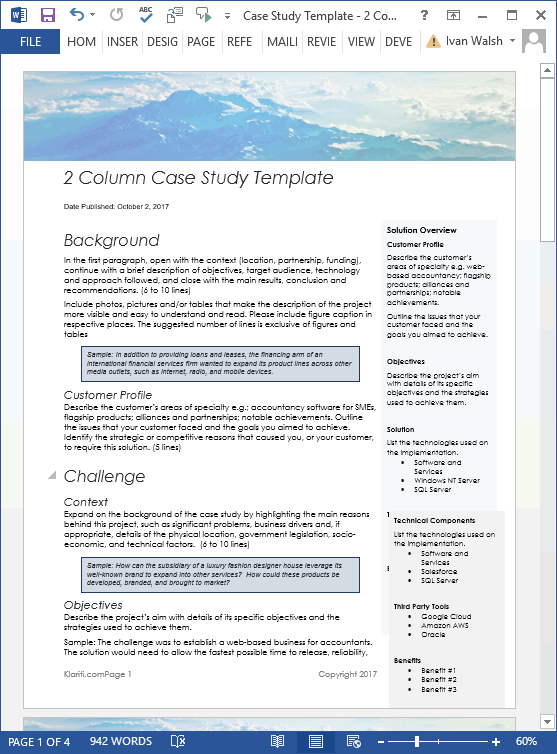Case Study Templates
3 Case Study Writing Tactics For First-Time Writers
If case study writing is new to you, and you’re looking for direction on how to start, follow these three guidelines.
One writing tactic to remember is that your case study must BEGIN with the outcome. Think about it.
Your reader is looking for evidence that your product might work for her. For this reason, you need to develop a business narrative that shows the similarity between your product and her current needs.
Remember the buyer’s journey? Case studies are very effective to raise awareness and connect, that is, to help with inbound marketing.
Develop themes that will resonate with the target reader. Weave their pain points into the narrative and keep looping back to how you can provide evidence that your solution works.
You need to substantiate what you’re saying.
With that in mind, let’s get started.

3 Case Study Writing Tactics For First-Time Writers
A case study is a soft-sell sales document. Its role is to highlight your abilities without resorting to market-speak and sales clichés.
An effective approach to catch the reader’s attention (who is frequently a potential client) is to explore how the solution helped end-users and the target group. This is part two in a series of articles about case studies, how to write them, how to format your presentations, and how to use them for strategy advantage.
#1 How To Build Your Case Study
Support your argument with direct quotes (with their names, if possible) from personnel who’ve adopted your system or use your services.
To make this work, concentrate on how the solution resolved one very specific issue and then build the case study around this.
Warning: Don’t complicate the case study by addressing multiple issues; stick to one subject and explain how you solved the problem in measurable and quantifiable terms.
Download Case Study Templates
#2 How to Provide Evidence
Support your case study with statistics, figures and tables.
Areas to focus on include:
1. Return on Investments – how did the investment in your product pay for itself. For example, it increased productivity by 50% within 2 months. Explain how you can substantiate this; otherwise, your argument loses credibility.
2. Cost Containment – how does the solution help companies contain costs? This area is very important as budgets are always a sensitive issue. If you can illustrate how another company who adopted your solution saved money then you will keep the reader’s interest.
3. Reducing Barriers – explain how your solution improves internal operations and assists management planning. For example, how does it fit into the system workflow and business procedures? Alternately, mention how your system integrates with other applications and business critical applications.
When compiling the final draft, avoid making it too dry and overwhelming the reader with excessive figures. Rather, keep the tone light, easy-to-read while highlighting the key points.
Remember: case studies that oversell themselves by proposing to solve all problems to all people don’t work. No-one believes such claims.
# How to Refine Your Case Study
Perfecting your case study takes hard work. But, once you refine the words and polish the edges, you have a very powerful marketing tool.
Indeed, those who download your Case Study will keep it on file and use it as a reference.

Once this occurs, the reader sees you as a credible, trustworthy and reliable source of information, the type of company people want to do business with.
Want to learn more about case study writing? Download tutorials here.
